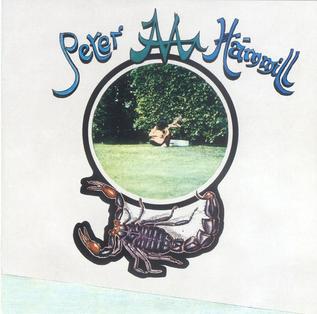Top Qs
Timeline
Chat
Perspective
Chameleon in the Shadow of the Night
1973 studio album by Peter Hammill From Wikipedia, the free encyclopedia
Remove ads
Chameleon in the Shadow of the Night is the second solo album by British singer-songwriter Peter Hammill. It followed in the aftermath of the breakup of Hammill's band Van der Graaf Generator, and (as with many of Hammill's solo albums from this period) other ex-members of Van der Graaf Generator perform on the album.
This article needs additional citations for verification. (March 2022) |
The album was produced by John Anthony at Rockfield Studios, Wales, for the first time using pre-recorded parts done by Peter Hammill in his home studio in Worth. For final mixing the then much better equipped Trident Studios were used. The album was released in May 1973 on Charisma Records.
Some of the songs ("German Overalls" and "In the End") relate to Van der Graaf Generator's decision to split, following an exhausting, demoralising and poverty-stricken experience of being a touring rock band.[3] "German Overalls" name-checks bandmates Hugh Banton and David Jackson.
Hammill has continued to perform "Easy to Slip Away" in concert to the present day. The song relates to him losing touch with student housemates Mike and actress Susan Penhaligon (who were also namechecked in the Van der Graaf Generator song "Refugees").
The complex and atmospheric "(In the) Black Room/The Tower" was originally planned for inclusion on Van der Graaf Generator's album following Pawn Hearts, an album that because of the band's split never came to be.[4] But the song was already performed on stage by Van der Graaf Generator in 1972, and a recording of it from July 1972 rehearsals (albeit in bad audio quality) is included on the compilation Time Vaults. The album version from Chameleon in the Shadow of the Night features Van der Graaf Generator's ex-members Banton, Jackson and Evans. Later, when the band reformed in 1975 and 1976, "(In the) Black Room" was again part of their live sets, and also during their 2005 reunion.
Remove ads
Cover
The cover was designed by Paul Whitehead, who also was the artist for Fool's Mate as well as sleeves for Van der Graaf Generator (The Least We Can Do is Wave to Each Other and Pawn Hearts) and Charisma labelmates Genesis (Trespass, Nursery Cryme and Foxtrot). It shows Peter Hammill's astrological sign Scorpio twice, as a painting of a real scorpion and as part of a personal logo which Hammill introduced with this album and which would appear on the covers of many coming releases. The photo of Hammill on the front side was taken by Bettina Hohls in Hamburg.
Remove ads
Track listing
All tracks are written by Peter Hammill.
Remove ads
Personnel
- Peter Hammill – vocals, acoustic and electric guitars (1–3, 5, 7), piano (3, 4, 6, 8), Mellotron (6), harmonium (credited with "tesseraschizoid warbling...one flight of mellotrons and some Gothic harmonium")
- Hugh Banton – Hammond organ (8), piano, bass pedals, bass guitar (credited with "Bomber, banshee, organ and leaping piano, foot and hand bass, the Rack")
- Guy Evans – drums, cymbals (3, 8) (credited with "The Thundering Horseman of the Darkest Dawn")
- David Jackson – acoustic and electric tenor and alto saxophone, flute (1, 3, 5, 6, 8) (credited with "screams in the night and icy waterfalls")
- Nic Potter – bass guitar (3, 6) (credited with "Cortina")
Technical
- John Anthony – producer
- Peter Hammill – recording engineer (Sofa Sound, Sussex)
- Pat Moran, Ralph Down – recording engineers (Rockfield Studios, Monmouth)
- David Hentschel – mixing (Trident Studios, London)
- Paul Whitehead – artwork
- John Pasche – art direction
- Bettina Hohls – photography
References
External links
Wikiwand - on
Seamless Wikipedia browsing. On steroids.
Remove ads

